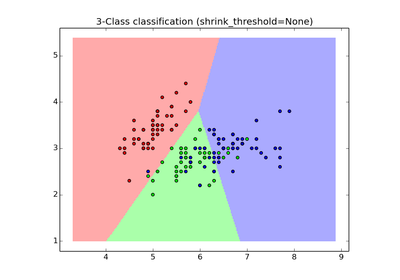sklearn.neighbors.NearestCentroid¶
- class sklearn.neighbors.NearestCentroid(metric='euclidean', shrink_threshold=None)¶
Nearest centroid classifier.
Each class is represented by its centroid, with test samples classified to the class with the nearest centroid.
Parameters: metric: string, or callable :
The metric to use when calculating distance between instances in a feature array. If metric is a string or callable, it must be one of the options allowed by metrics.pairwise.pairwise_distances for its metric parameter.
shrink_threshold : float, optional (default = None)
Threshold for shrinking centroids to remove features.
Attributes: `centroids_` : array-like, shape = [n_classes, n_features]
Centroid of each class
See also
- sklearn.neighbors.KNeighborsClassifier
- nearest neighbors classifier
Notes
When used for text classification with tf-idf vectors, this classifier is also known as the Rocchio classifier.
References
Tibshirani, R., Hastie, T., Narasimhan, B., & Chu, G. (2002). Diagnosis of multiple cancer types by shrunken centroids of gene expression. Proceedings of the National Academy of Sciences of the United States of America, 99(10), 6567-6572. The National Academy of Sciences.
Examples
>>> from sklearn.neighbors.nearest_centroid import NearestCentroid >>> import numpy as np >>> X = np.array([[-1, -1], [-2, -1], [-3, -2], [1, 1], [2, 1], [3, 2]]) >>> y = np.array([1, 1, 1, 2, 2, 2]) >>> clf = NearestCentroid() >>> clf.fit(X, y) NearestCentroid(metric='euclidean', shrink_threshold=None) >>> print(clf.predict([[-0.8, -1]])) [1]
Methods
fit(X, y) Fit the NearestCentroid model according to the given training data. get_params([deep]) Get parameters for this estimator. predict(X) Perform classification on an array of test vectors X. score(X, y[, sample_weight]) Returns the mean accuracy on the given test data and labels. set_params(**params) Set the parameters of this estimator. - __init__(metric='euclidean', shrink_threshold=None)¶
- fit(X, y)¶
Fit the NearestCentroid model according to the given training data.
Parameters: X : {array-like, sparse matrix}, shape = [n_samples, n_features]
Training vector, where n_samples in the number of samples and n_features is the number of features. Note that centroid shrinking cannot be used with sparse matrices.
y : array, shape = [n_samples]
Target values (integers)
- get_params(deep=True)¶
Get parameters for this estimator.
Parameters: deep: boolean, optional :
If True, will return the parameters for this estimator and contained subobjects that are estimators.
Returns: params : mapping of string to any
Parameter names mapped to their values.
- predict(X)¶
Perform classification on an array of test vectors X.
The predicted class C for each sample in X is returned.
Parameters: X : array-like, shape = [n_samples, n_features] Returns: C : array, shape = [n_samples] Notes
If the metric constructor parameter is “precomputed”, X is assumed to be the distance matrix between the data to be predicted and self.centroids_.
- score(X, y, sample_weight=None)¶
Returns the mean accuracy on the given test data and labels.
Parameters: X : array-like, shape = (n_samples, n_features)
Test samples.
y : array-like, shape = (n_samples,)
True labels for X.
sample_weight : array-like, shape = [n_samples], optional
Sample weights.
Returns: score : float
Mean accuracy of self.predict(X) wrt. y.
- set_params(**params)¶
Set the parameters of this estimator.
The method works on simple estimators as well as on nested objects (such as pipelines). The former have parameters of the form <component>__<parameter> so that it’s possible to update each component of a nested object.
Returns: self :



